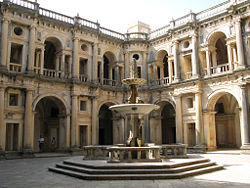
Filippo Terzi
Encyclopedia

Bologna
Bologna is the capital city of Emilia-Romagna, in the Po Valley of Northern Italy. The city lies between the Po River and the Apennine Mountains, more specifically, between the Reno River and the Savena River. Bologna is a lively and cosmopolitan Italian college city, with spectacular history,...
, who went to Lisbon
Lisbon
Lisbon is the capital city and largest city of Portugal with a population of 545,245 within its administrative limits on a land area of . The urban area of Lisbon extends beyond the administrative city limits with a population of 3 million on an area of , making it the 9th most populous urban...
in 1577 and the following year joined the disastrous military expedition to Morocco
Morocco
Morocco , officially the Kingdom of Morocco , is a country located in North Africa. It has a population of more than 32 million and an area of 710,850 km², and also primarily administers the disputed region of the Western Sahara...
where he was taken prisoner at the battle of Alcácer Quibir
Battle of Alcácer Quibir
The Battle of Ksar El Kebir, also known as Battle of Three Kings, or "Battle of Oued El Makhazeen" in Morocco, and Battle of Alcácer Quibir in Portugal , was fought in northern Morocco, near the town of Ksar-el-Kebir and Larache, on 4 August 1578...
, after which his release was negotiated and he returned to Portugal
Portugal
Portugal , officially the Portuguese Republic is a country situated in southwestern Europe on the Iberian Peninsula. Portugal is the westernmost country of Europe, and is bordered by the Atlantic Ocean to the West and South and by Spain to the North and East. The Atlantic archipelagos of the...
, where he spent the remainder of his career, dying at Setúbal
Setúbal
Setúbal is the main city in Setúbal Municipality in Portugal with a total area of 172.0 km² and a total population of 118,696 inhabitants in the municipality. The city proper has 89,303 inhabitants....
.
In 1582 Philip II of Spain
Philip II of Spain
Philip II was King of Spain, Portugal, Naples, Sicily, and, while married to Mary I, King of England and Ireland. He was lord of the Seventeen Provinces from 1556 until 1581, holding various titles for the individual territories such as duke or count....
, recently declared king also of Portugal, visited
Setúbal, where Terzi was recommended to him on the occasion of a new fortification needed to reinforce the security of that port city. Having achieved the work successfully, Terzi was named master of work at the Convento de Cristo in Tomar, in 1584.
In 1590, he was named Mestre das Obras de el-Rei, "Master of the King's works", succeeding the post that had been occupied by António Rodrigues
António Rodrigues
António Rodrigues is a Portuguese actor, screenwriter and director. He is also a dramatist, producer and musician.-Biography:...
. Terzi was also charged with the instruction of a new generation of young architects in the Royal Works. He was responsible for numerous projects, notably at Coimbra
Coimbra
Coimbra is a city in the municipality of Coimbra in Portugal. Although it served as the nation's capital during the High Middle Ages, it is better-known for its university, the University of Coimbra, which is one of the oldest in Europe and the oldest academic institution in the...
and Lisbon, including the aqueduct that led from São Sebastião to Coimbra.
Selected works
- Convento de Cristo, TomarTomarTomar Municipality has a total area of 351.0 km² and a total population of 43,007 inhabitants.The municipality is composed of 16 parishes, and is located in Santarém District...
: cloister - church of São Vincente de Flora, Lisbon (1582–1605)
- Fort of Pessegueiro (1588-90), a coastal fortress in which the island of Pessegueiro was linked to the mainland
- Fort of Santiago da Barra
- Fort of São Filipe de Setúbal (1597) was in progress when he died.
- Igreja de São Roque (Lisbon)Igreja de São Roque (Lisbon)The Igreja de São Roque in Lisbon was the earliest Jesuit church in the Portuguese world, and one of the first Jesuit churches anywhere. It served as the Society’s home church in Portugal for over 200 years, before the Jesuits were expelled from that country...
(Church of São Roque); completed the construction, including the roof

